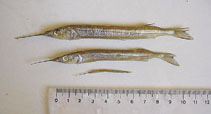| Family: |
Hemiramphidae (Halfbeaks) |
| Max. size: |
30 cm TL (male/unsexed) |
| Environment: |
reef-associated; brackish; marine; depth range 0 - 5 m, oceanodromous |
| Distribution: |
Western Atlantic: south Florida (USA), through the Caribbean and along the coasts of Central and South America to Uruguay. |
| Diagnosis: |
Body elongate; lower jaw very prolonged; upper jaw short, triangular, and scaly; lower branch of first gill arch with 29 to 38 gill rakers; fins lacking spines; pectoral fins not very long; caudal fin emarginate or slightly forked; anal fin with 15 to 18 rays; back greenish, with 3 narrow, dark, bars; flanks and belly silvery white; fleshy border of lower jaw red; caudal fin light colored with dark tips (Ref. 55763). |
| Biology: |
An inshore, surface-dwelling species forming sizeable schools, frequently entering estuaries (Ref. 3723). Uncommon over reefs (Ref. 9710). Omnivorous, feeds on algae and other small animals (Ref. 3723). Caught with 'mandinga' nets in Venezuela, often using lights (Ref. 3723). Edible but not really appreciated (Ref. 3723). |
| IUCN Red List Status: |
Least Concern (LC); Date assessed: 01 March 2019 Ref. (130435)
|
| Threat to humans: |
reports of ciguatera poisoning |
Source and more info: www.fishbase.org. For personal, classroom, and other internal use only. Not for publication.
